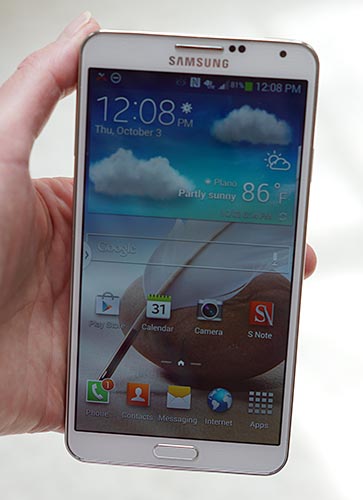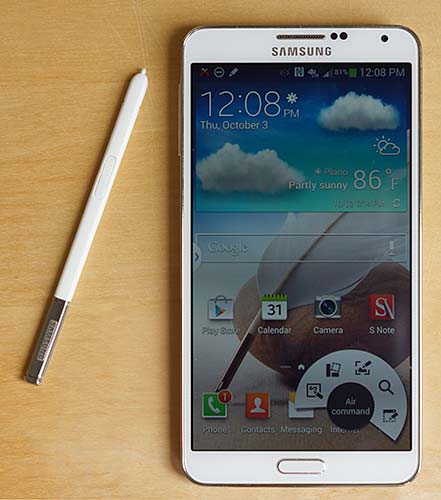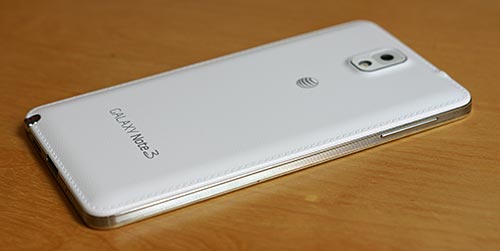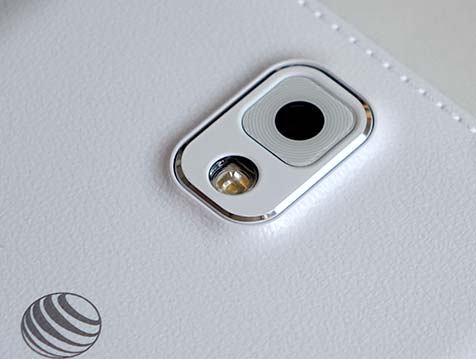Samsung Galaxy Note 3 Review
13:19
Like most third generation flagships, the Samsung Galaxy Note 3 needs no introduction. That doesn't mean it's dull--anything but! The first Galaxy Note was a groundbreaking smartphone that inspired the word "phablet": the marriage of phone and small tablet. With each generation the Note's display gets larger but the device doesn't. That means the Note 3 has a huge 5.7" display, and though it's a bigger phone than its mid-sized companion, the Samsung Galaxy S4, it's not insanely large like the Samsung Galaxy Mega 6.3 or Sony Xperia Z Ultra. It's one of the few oversized smartphones that's big but still manageable.

The Note 3 runs on the latest, greatest Qualcomm Snapdragon 800 CPU with 3 gigs of RAM. This is the first Android smartphone with that much RAM and it needs it for all the Samsung custom software. The quad core Snapdragon 800 is clocked at 2.3GHz, and the phone performs all tasks quickly, with little if any TouchWiz-induced lag. Given recent news about Samsung's benchmark manipulation, we won't say much about the Note 3's synthetic performance except that the Snapdragon 800 is one of the fastest mobile CPUs and the Galaxy Note 3 is a top performer. It really doesn't need to cheat... silly Samsung.
The phablet has 32 gigs of internal storage and a removable back that grants access to the micro SIM card slot, micro SD card slot and battery. It weighs just 5.9 ounces thanks to those thin plastics Samsung loves. The company has addressed their glossy plastics image problem with a new faux leather injection molded plastic back, complete with fake stitching. The phone is available in your choice of white or black with faux chrome trim, and I think the visual and textural treatment looks nice. Yes, the back cover is still flexible and wafer thin, but the phone is no longer a slippery fingerprint magnet. Would we love to see a Samsung Android phone with the classy looks of their higher end ATIV Book laptops? Sure. We can dream.
The Note 3 has a front 2MP camera, rear 13MP camera with LED flash (just like the Samsung Galaxy S4), WiFi 802.11ac, Bluetooth 4.0, NFC and a GPS with GLONASS. It runs Android 4.3 Jelly Bean with Samsung TouchWiz software. The phone has a USB 3.0 port (that's rare) but the custom connector is backward compatible with micro USB 2.0 cables. A USB 3.0 cable is included.
The phone supports USB host and you can use USB keyboards, mice, game controllers and flash drives (NTFS format isn't supported). You'll need a micro USB to USB OTG host adapter cable to use this features. As with the Samsung Galaxy Note 8.0, 2014 Edition Samsung Galaxy Note 10.1 and Samsung Galaxy S4 (via a software update), the phone supports moving apps to to an SD card, a feature that Samsung added since Google removed the ability to install apps to SD cards with Android 4.0 and above.

S Pen Digital Pen and Samsung Software
The Note 3 has Samsung's S-Pen, their name for a Wacom digital pen and active digitizer. This staple of the Samsung Galaxy Note phone and tablet line works well as ever with pressure sensitivity, good tracking and smooth response. It's great for drawing and note taking--worlds better than a capacitive stylus.  Samsung throws even more software at the pen, from the nicely evolved S Note to a strange feature where you draw a rectangle on the screen to reveal a collection of quick-launcher apps like calculator and YouTube. That's a little over the top, but Samsung's software has been over the top for some time now. Samsung also bundles Autodesk's Sketchbook for Galaxy: a very nice touch for artists who like to sketch with natural media pencils and brushes. Pressure sensitivity and palm rejection work perfectly in the built-in notes and drawing apps, Sketchbook and most "serious" third party notes and art apps that are Wacom-aware (again, the S Pen is a Wacom pen). As with the Note 2, S Pens for other Samsung Note tablets and smartphones work, as do Wacom pens meant for Tablet PCs (e.g.: Samsung ATIV 700t, Lenovo ThinkPad Helix,Microsoft Surface Pro and Pro 2 pen). N-Trig pens aren't compatible (e.g.: Sony Vaio Duo 13, HTC Flyer, Asus Taichi pen). You could use a capacitive stylus, but why would you ever want to do that? They're fatter, much less precise and don't have pressure sensitivity or palm rejection.
Samsung throws even more software at the pen, from the nicely evolved S Note to a strange feature where you draw a rectangle on the screen to reveal a collection of quick-launcher apps like calculator and YouTube. That's a little over the top, but Samsung's software has been over the top for some time now. Samsung also bundles Autodesk's Sketchbook for Galaxy: a very nice touch for artists who like to sketch with natural media pencils and brushes. Pressure sensitivity and palm rejection work perfectly in the built-in notes and drawing apps, Sketchbook and most "serious" third party notes and art apps that are Wacom-aware (again, the S Pen is a Wacom pen). As with the Note 2, S Pens for other Samsung Note tablets and smartphones work, as do Wacom pens meant for Tablet PCs (e.g.: Samsung ATIV 700t, Lenovo ThinkPad Helix,Microsoft Surface Pro and Pro 2 pen). N-Trig pens aren't compatible (e.g.: Sony Vaio Duo 13, HTC Flyer, Asus Taichi pen). You could use a capacitive stylus, but why would you ever want to do that? They're fatter, much less precise and don't have pressure sensitivity or palm rejection.
 Samsung throws even more software at the pen, from the nicely evolved S Note to a strange feature where you draw a rectangle on the screen to reveal a collection of quick-launcher apps like calculator and YouTube. That's a little over the top, but Samsung's software has been over the top for some time now. Samsung also bundles Autodesk's Sketchbook for Galaxy: a very nice touch for artists who like to sketch with natural media pencils and brushes. Pressure sensitivity and palm rejection work perfectly in the built-in notes and drawing apps, Sketchbook and most "serious" third party notes and art apps that are Wacom-aware (again, the S Pen is a Wacom pen). As with the Note 2, S Pens for other Samsung Note tablets and smartphones work, as do Wacom pens meant for Tablet PCs (e.g.: Samsung ATIV 700t, Lenovo ThinkPad Helix,Microsoft Surface Pro and Pro 2 pen). N-Trig pens aren't compatible (e.g.: Sony Vaio Duo 13, HTC Flyer, Asus Taichi pen). You could use a capacitive stylus, but why would you ever want to do that? They're fatter, much less precise and don't have pressure sensitivity or palm rejection.
Samsung throws even more software at the pen, from the nicely evolved S Note to a strange feature where you draw a rectangle on the screen to reveal a collection of quick-launcher apps like calculator and YouTube. That's a little over the top, but Samsung's software has been over the top for some time now. Samsung also bundles Autodesk's Sketchbook for Galaxy: a very nice touch for artists who like to sketch with natural media pencils and brushes. Pressure sensitivity and palm rejection work perfectly in the built-in notes and drawing apps, Sketchbook and most "serious" third party notes and art apps that are Wacom-aware (again, the S Pen is a Wacom pen). As with the Note 2, S Pens for other Samsung Note tablets and smartphones work, as do Wacom pens meant for Tablet PCs (e.g.: Samsung ATIV 700t, Lenovo ThinkPad Helix,Microsoft Surface Pro and Pro 2 pen). N-Trig pens aren't compatible (e.g.: Sony Vaio Duo 13, HTC Flyer, Asus Taichi pen). You could use a capacitive stylus, but why would you ever want to do that? They're fatter, much less precise and don't have pressure sensitivity or palm rejection.
The basics like multi-window multitasking where you can split two apps into half screen is still here (we love this on a big screen phone or tablet), as is the feature that keeps the screen turned on if you're looking at the phone. It can pause video playback if you look away from the screen, play video in a floating resizable window and respond to hand gestures just as with the Galaxy S4 phone. Air View can show you more info when you hover the pen or a finger over something on screen. For example, if you hover over Gallery's listing of your camera photos, you'll get a pop-up contact sheet showing those photos. Samsung's left side quick launcher is here (press and hold the back button to make it appear and disappear), and there are more apps than ever supported. These include the webkit web browser, Chrome, email, Gmail, ChatOn, contacts, messaging, Samsung's music player, S Finder, S Note, Samsung's video player, Hangouts, My Files, Maps and YouTube. Honestly, one could easily write a 5 page review simply covering all of Samsung's added software--some of it genuinely useful like Multi Window and others that are easily forgotten like the page scrolling feature that tries (and often fails) to track your eyes.
Display
Super AMOLED once again, but the resolution is now full HD 1920 x 1080, which compares favorably to the 720p Note II. On a 4.5 to 4.7" phone, one could easily argue that 720p is plenty good, but at 5.7", 1080p is a must to achieve really smooth text and sharp looking photos. The 386 PPI Galaxy Note 3 doesn't disappoint there: text is indeed sharp, and despite the (improved) Pentile Matrix, I couldn't see individual pixels or halos on text. It's a lovely looking display with AMOLED's signature deep blacks, and whites are closer to white than ever for Super AMOLED. Outdoor visibility, a sore point for Samsung Super AMOLED displays has been improved with even higher max brightness, but there's a trick: you'll only get that augmented brightness if you step outdoors into the sunlight and have auto-brightness turned on. Samsung does this so you don't tank battery life by leaving it on super brightness all the time, but it's a bit annoying since I rarely enable auto-brightness since it's too dim for my liking. Even when that higher brightness kicks in, the display is a bit muddy in sunlight, and phones with IPS or Super LCD displays like the iPhone 5s, LG G2 and HTC One are much more viewable. Like some Nokia Lumia phones, the Note 3 has an option for heightened display sensitivity that works with gloved fingers.
But let's talk livin' large: this is the apex of big screen joy without carrying around something that feels like a tablet. The colorful (even if overly vibrant) display is superb for watching videos and viewing web pages. Movies are much more immersive at 5.7" and web pages require less zooming. How about eBooks? Though Super AMOLED isn't my favorite for long form reading, the Note 3 display is fairly color neutral and text is very sharp. Combine that with the big display and you get more words per page than on a smaller screen phone (without resorting to 6 point fonts). Sweet!
Calling and Data
Call quality on our AT&T review unit is excellent, just as with the Samsung Galaxy S4 and the Note 2. Incoming and outgoing voice are very clear and reasonably full and we heard no background hiss or white noise. Noise rejection is quite good thanks to the multiple mic setup. We tested a variety of popular Motorola, Samsung and Jawbone Bluetooth headsets as well as built-in BMW car Bluetooth and it worked perfectly with good volume and clarity.
Noise rejection is quite good thanks to the multiple mic setup. We tested a variety of popular Motorola, Samsung and Jawbone Bluetooth headsets as well as built-in BMW car Bluetooth and it worked perfectly with good volume and clarity.
 Noise rejection is quite good thanks to the multiple mic setup. We tested a variety of popular Motorola, Samsung and Jawbone Bluetooth headsets as well as built-in BMW car Bluetooth and it worked perfectly with good volume and clarity.
Noise rejection is quite good thanks to the multiple mic setup. We tested a variety of popular Motorola, Samsung and Jawbone Bluetooth headsets as well as built-in BMW car Bluetooth and it worked perfectly with good volume and clarity.
Data speeds were excellent on AT&T's 4G LTE network in the Dallas area, and the phone averaged 18Mbps down and 12 Mbps up according to the Speedtest.net app. That matches the GS4, iPhone 5s and HTC One on the same carrier.
Samsung Galaxy Note 3 vs. the Competition
For those of you who own a Note 2 and likely still have a year to go before your contract is up for a subsidized renewal, I'd understand if you passed on the Note 3. Not that the Note 3 isn't faster with a higher resolution display and a better camera--but those are evolutionary changes, much as we see with other sequels. The Galaxy Note 2 is still a fast phone with a good looking and large display and the camera is pretty good. If you're faced with a $750 off contract purchase, moving from the Note 2 to Note 3 might be a daunting purchase unless you're well off and a smartphone enthusiast.
If you own a Samsung Galaxy S III or even the Galaxy S4 but really want a bigger display or the S Pen digital pen, then the Note 3 is an appealing move. However, if you find the GS4 is already pushing your hand and pocket's limits, the Galaxy Note 3 may feel too big.
How about the iPhone 5s? I'm still surprised that many of you are considering two phones that are so fundamentally different. Maybe you're considering these two because they represent the best of iOS vs. the best of phablets? The iPhone 5s is much smaller, runs a very different OS and has no pen. But just in case you're on the fence, watch our Note 3 vs. iPhone 5s comparison smackdown video above.
Camera
As far as we can tell, these are the same very good 2MP front and 13MP rear cameras used in the Samsung Galaxy S4. The rear camera takes extremely detailed and colorful photos. Low light? Not as impressive when compared to the HTC One and iPhone 5s with their larger sensor pixels. The camera has a BSI sensor, HDR mode for photos and both 4k and 1080p video recording. This is the first time we've seen 4k recording on a US phone and it does indeed capture added detail with a few caveats. The phone's processor can handle only so much, so features like simultaneous front-rear camera recording and digital image stabilization are disabled. We can easily live without dual camera recording, but without digital (or optical) image stabilization, videos are very jittery. You'll definitely want to sit or stand still rather than walk when shooting 4k video. The front 2 megapixel camera worked well for fairly clear and bright video chats.

Samsung's camera UI is excellent, and it's based on the Galaxy Camera's UI, and is the same as the GS4's. It's very easy to select between the various shooting modes and it's clear what each one does. Samsung's unique Drama mode stitches together several images taken in succession: perfect for sports or fast moving children and you'll end up with a photo of your subject moving across the frame. Sound & Shot is also cool: it captures a few seconds of sound when you take a photo. Well done. These accessible camera modes will tickle your creative funny bone. The end result is that you'll likely take more photos and have more fun looking at them afterward.
For more serious photographers, there are myriad settings and tweaking them can yield even better shots; hint: turn on digital video stabilization which is turned off by default, and play with the different photo metering modes for best exposure. Those who are serious photo buffs like me will appreciate the detailed photos, good overall exposure and lack of unwanted digital processing artifacts. The average user who just wants a bright shot with good contrast will also be pleased, but we found the default settings weren't always the best to capture the ideal shot.
Battery Life
Giant phones can have giant battery life. The Note 2 was no slouch and the Note 3 adds 100 mAh of capacity while doing a good job of juggling the demands of a 2.3GHz quad core CPU, 4G LTE and a 5.7" full HD display. The battery is removable, so you can purchase a spare and swap it in on the road. While other smartphone manufacturers are ditching removable batteries in droves, we can count on Samsung to provide this feature. The 3200 mAh Lithium Ion battery routinely lasted us 1.5 days on a charge with moderate use. That's better than most big screen flagship smartphones and the iPhone 5s with its much smaller battery--they generally last us a day of moderate use that includes 30 minutes of calls, streaming HD video for 45 minutes, playing music with the screen off for an hour, web browsing for an hour and checking email via push and IMAP idle.


0 comments